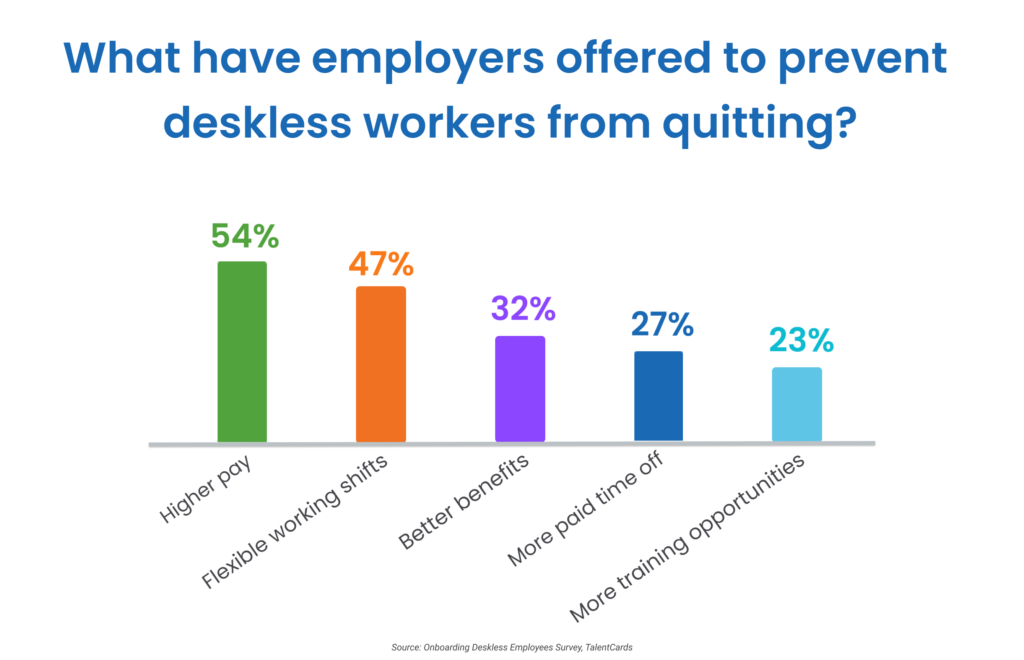Ensuring a robust employee retention rate should be a top priority for your human resources department. Attracting and retaining top talent is critical to the success of your business. A high retention rate means you have satisfied employees working at top levels. Consequently, this leads to higher customer satisfaction and better outcomes for your business.
Tracking your employee retention rate will show if your human resources program is functioning properly. If your rate dips below 90%, it’s time to reevaluate your systems. Consider your onboarding process, compensation packages, and training development programs. Keeping your staff engaged is critical to maintaining strong retention rates.
Read on to learn how to calculate your employee retention rate, its impact on your business, and strategies to keep it at an optimal level.
What is employee retention?
Employee retention rate definition
Employee retention is the measure of the percentage of employees who choose to remain with your organization over a specific timeframe. This rate is a critical aspect of organizational success and is directly impacted by your ability to retain and engage valuable talent within your company.
Keeping a close eye on this metric lets organizations see if their human resources efforts are working, and if the company culture as a whole is productive and positive.
A high retention rate shows staff are engaged, satisfied, and will likely continue working for the company.
Conversely, a low retention rate raises concerns about employee dissatisfaction and an unfavorable work environment.
Understanding why employee retention matters to businesses is paramount. It cultivates a pool of tenured employees with a wealth of experience and knowledge, resulting in heightened performance and productivity.
Why employee retention matters to your businesses
Maintaining a high retention rate offers several benefits. Long-term employees possess a deep understanding of their roles and responsibilities, as well as your company’s mission and values. Long standing employees tend to work with increased efficiency and consistently deliver high-quality work. And when these employees are satisfied in their company, they have a powerful impact on fostering a positive work environment for more recently hired employees.
In addition to having a positive and productive work environment, retaining employees for longer durations reduces recruitment and training expenses associated with high turnover rates, leading to improved financial outcomes.
Factors influencing employee retention rates
Many factors influence retention rates. The good news is tracking the data helps identify areas of improvement in the employee’s work environment and experience.
Overall factors that influence employee retention
An employer’s capacity to retain employees is highly influenced by the following:
- Onboarding and training (or a lack thereof) leaves staff feeling unprepared, leading to poor performance outcomes.
- Compensation and benefits should be at least on par with industry standards.
- Career development opportunities are a leading reason why employees stay with a company long-term.
- Employee recognition and rewards let your staff know they are valued. Learn how integrating a spot bonus program can improve your rewards system.
- Company culture and values help employees feel connected to the company’s mission. Sixty-three percent of deskless workers reported access to more training would improve their connection to the company’s values and mission.
Industry-specific factors
Each industry faces challenges in retaining employees, but those that employ deskless employees tend to have even more severe challenges than those employing office-bound employees. With deskless workers making up 80% of the global workforce, it’s important to consider their unique needs.
According to a survey of 900 onboarding managers employed in deskless industries, 19% of new hires quit in less than one year.
The following are a few examples of challenges within deskless industries
- Manufacturing: physically demanding work, monotonous tasks, or inadequate work conditions
- Healthcare: demanding workloads, irregular schedules, high-stress levels, or burnout
- Hospitality: low wages, long working hours, or limited advancement opportunities
Generational factors
Baby Boomers, Generation X, Millennials, and Generation Z, have unique workplace priorities and place different weight on different factors. Understanding these differences is essential to tailor your retention strategies. For example:
- Baby Boomers: Job security, opportunities for professional growth, and retirement benefits are valued the most. Providing these incentives can help retain these experienced employees.
- Generation X: Recognition, autonomy, and career development are important here. Acknowledging their achievements, allowing them to have independence, and giving them a chance to move up in their career will help keep your Gen X’ers with the company.
- Millennials: Work-life balance, career development, and a sense of purpose in their work are needed. Offering flexible schedules, opportunities for learning and advancement, and a meaningful company mission can keep your millennial staff engaged.
- Generation Z: Opportunities for growth, a collaborative work environment, and access to the latest technology are top priorities. Providing mentorship programs, promoting teamwork, and leveraging cutting-edge tools will improve your likelihood of retaining Gen Z employees.
The impact of high employee retention
According to SHRM, the average cost for a new hire is $4,700. Constantly having to attract, hire, and train talent consumes valuable company dollars. Keeping your retention rates high means you can focus on growing your business, rather than playing catch up.
Enhanced productivity and performance
An employee who has been with a company for a long time has a deep understanding of the culture. Expectations are easily met and they have more opportunities for growth. With this understanding, they are efficient and more effective in their roles. All of this leads to better work quality.
Cost savings and reduced turnover expenses
Employee retention and turnover rate are often discussed in tandem, yet they are not the same. Employee retention means how many employees stay at a given time. Employee turnover measures how many employees leave.
When employees leave, there is a cost to find and train new ones. These include advertising job openings, paying recruiters, conducting interviews, and onboarding costs. We also shouldn’t forget the cost that is associated with the gap in productivity and output that exists from the time an employee leaves the company, to the time your new hire is able to perform at the standard that your previous employee was operating at.
A high retention and low turnover rate help keep employee morale and engagement high. If your staff is tenured, it improves your company’s reputation. A positive reputation leads to attracting high-quality talent, customers, and partners.
How to calculate your employee retention rate
To calculate your retention rate, first decide the timeframe that you’re measuring. It can be yearly, quarterly, or monthly.
You’ll need two numbers, the number of employees on day one of your time period, and the number of employees on the last day of the given time. It’s important not to count anyone hired during that time. Divide the final headcount by the starting headcount. Multiply that number by 100 to get your retention rate.

Let’s give it a try:
At the beginning of the quarter, you had 54 employees. Three people moved on to pursue outside opportunities, leaving you with 51 employees. In this case, your employee retention rate would be (51/54) X 100 = 94.44%.
In this case, you have a strong employee retention rate.
What is a good employee retention rate? An average of 90% or higher is the goal.
Now that you have your rate, compare it to your past numbers and industry standards. Doing this will help you see if your rate is under, above, or on track.
If your retention rate is below average, it’s time to put on your detective hat. Start investigating why employees might be leaving.
Are there issues with compensation, work environment, or career growth opportunities? By identifying the root causes, you can develop targeted strategies for improvement.
Even if you have a high employee retention rate, it’s still best practice to examine each case individually if and when an employee decides to leave the company. The information you learn can help you prevent a lower retention rate in the future.
Remember, employee retention rate is not just a number— it’s a window into your company’s relationship with its employees. It helps you gauge their satisfaction, providing valuable insights into your workforce stability.
Strategies for improving your retention rate
Now that we’ve identified factors that influence employee retention rate, let’s explore strategies to help you nurture your current employees. The focus is on creating a positive work environment and providing opportunities for growth and engagement.
First let’s take a look at what strategies companies that employ deskless workers have already rolled out to prevent employees from quitting:
In addition to the tangible and monetary benefits you can provide, it’s important to focus on these less tangible initiatives that also mean a lot to employees:

Create a positive work environment
Above all else, this should be your goal. Create a culture of respect, open communication, and teamwork. Encourage collaboration between team members and departments. Celebrate achievements and create a supportive atmosphere where employees are motivated to give their best.
Establish strong relationships with your staff
Build solid working relationships through trust and mutual respect. Invest the time in getting to know them individually. Understand their goals and provide support. Regularly communicate with your employees. Provide constructive feedback and address any concerns they may have. Employees who feel supported will likely stay committed to you and your business.
Provide growth and advancement opportunities
In a survey of 1,000 full time employees conducted by TalentLMS, 76% reported that they are more likely to stay with a company that offers continuous training. Providing high-quality training programs, mentorship opportunities, and job rotations is key. Consistent performance evaluations and constructive feedback will identify strengths and areas for improvement. Investing in professional growth demonstrates your commitment to their success.
Enhance employee engagement
When employees feel connected to their work and the overall vision of the organization, they are more likely to remain committed. You can achieve this by involving them in decision-making processes, giving them autonomy over their work, and promoting a culture of innovation. Create channels for employees to share their ideas.
Implement an effective onboarding process
A strong onboarding process sets the foundation for employee retention. This is especially true when it comes to onboarding deskless employees who face challenges due to being away from a central working location.
Design a comprehensive onboarding program that meets the needs of your new employee. Introduce the company culture, values, and expectations. Assign mentors to support new employees in navigating their roles. Provide clarity on job responsibilities, resources, and available support systems. A positive onboarding experience helps retain your valuable employees.
Deliver training to your deskless employees, no matter where the job takes them.

FAQs
What is a good employee retention rate?
90% or higher is the rate you want to aim for. This number varies depending on location, industry, and job type.
What are employee retention rate examples?
On March 1st you start with 200 employees. On March 31st you have 192 employees remaining. To calculate your retention rate divide the remaining employee number by the starting employee total and multiply that by 100. (192 ÷ 200) X 100 = 96% monthly retention rate.
What is the formula for employee retention rate?
To calculate retention rate divide your final headcount by your starting headcount. Multiply that number by 100 to get your retention rate.

What is employee retention vs turnover rate?
Employee retention means how many employees you keep, while employee turnover is how many employees you lost. So if your retention rate is 96%, your turnover rate is 4%.
What is the average employee retention year?
Typically an average is 90% or higher.
Create a thriving business with a staff that lasts
Prioritizing your employee retention rate is an investment in your business’s success. Understanding, measuring, and continuously improving your retention efforts can cultivate a committed workforce that propels your organization forward.
Key takeaways
- Employee retention rate measures the percentage of employees who stay with a company over a specific period. A high retention rate indicates employee satisfaction, a positive sign for your business.
- Industry-specific challenges and generational differences contribute to employees staying with a company. You should tailor retention strategies to meet the unique needs of your workforce.
- Retaining employees reduces turnover expenses and creates a positive work environment.
- Calculating and benchmarking your employee retention rate provides insights into your human resources effectiveness. This can help identify areas for improvement.
- Some strategies for improving employee retention include:
– creating a positive work environment
– establishing strong relationships with employees
– providing advancement opportunities
– providing training and development opportunities
– implementing effective onboarding processes


